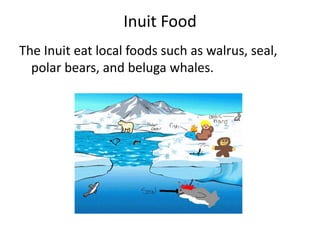The Inuit people live in northern Canada. They traditionally consume a diet of locally available foods like walrus, seals, polar bears, beluga whales, caribou, muskoxen, birds, fish and gathered plants. This meat-heavy diet provides warmth and nutrition in the Arctic climate. The Inuit eat these local wild foods because it keeps their bodies strong and healthy for their environment.


![DO NOT DO THIS!!!!!
• Inuit Food
• Inuit consume a diet of foods that are fished, hunted, and gathered
locally. This may include walrus, Ringed Seal, Bearded Seal, beluga
whale, caribou, polar bear, muskoxen, birds (including their eggs)
and fish. While it is not possible to cultivate plants for food in the
Arctic, the Inuit have traditionally gathered those that are naturally
available. Grasses, tubers, roots, stems, berries, fireweed and
seaweed (kuanniq or edible seaweed) were collected and preserved
depending on the season and the location.[1][2][3][4][5][6][7] According
to Edmund Searles in his article "Food and the Making of Modern
Inuit Identities," they consume this type of diet because a mostly
meat diet is "effective in keeping the body warm, making the body
strong, keeping the body fit, and even making that body healthy".[6]](https://image.slidesharecdn.com/inuit-130214121324-phpapp01/85/Inuit-3-320.jpg)



